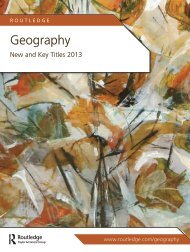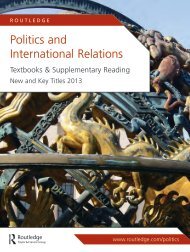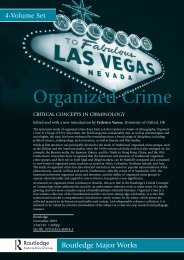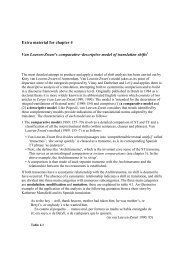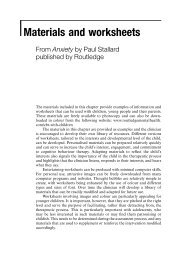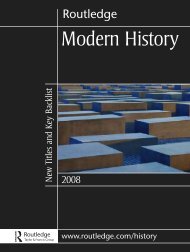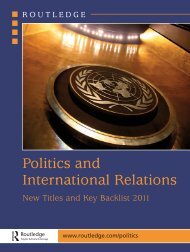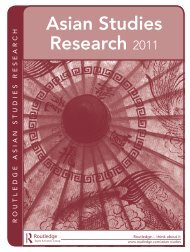Easily na - Routledge
Easily na - Routledge
Easily na - Routledge
You also want an ePaper? Increase the reach of your titles
YUMPU automatically turns print PDFs into web optimized ePapers that Google loves.
new<br />
The Diplomatic History<br />
of Postwar Japan<br />
Edited by Makoto Iokibe, Natio<strong>na</strong>l Defence<br />
Academy of Japan & Kobe University, Japan<br />
Translated and Annotated by Robert D. Eldridge,<br />
Osaka University, Japan<br />
Winner of the prestigious<br />
Yoshida Shigeru Prize 1999 for<br />
the best book in public history<br />
when it was published in it’s<br />
origi<strong>na</strong>l Japanese, this book<br />
presents a comprehensive and<br />
up-to-date overview of Japan’s<br />
inter<strong>na</strong>tio<strong>na</strong>l relations from the<br />
end of the Pacific War to the<br />
present. Written by leading<br />
Japanese authorities on the<br />
subject, it makes extensive use<br />
of the most recently declassified<br />
Japanese documents, memoirs, and diaries. It introduces<br />
the perso<strong>na</strong>lities and approaches Japan’s postwar leaders<br />
and statesmen took in dealing with a rapidly changing<br />
world and the challenges they faced. Importantly, the<br />
book also discusses the evolution of Japan’s presence on<br />
the inter<strong>na</strong>tio<strong>na</strong>l stage and the important – if<br />
underappreciated role – Japan has played.<br />
Selected Contents: Introduction: Japanese Diplomacy from<br />
Prewar to Postwar Iokibe Makoto 1. Diplomacy in Occupied<br />
Japan: Japanese Diplomacy in the 1940s Iokibe Makoto<br />
2. The Conditions of an Independent State: Japanese<br />
Diplomacy in the 1950s Sakamoto Kazuya 3. The Model<br />
of an Economic Power: Japanese Diplomacy in the 1960s<br />
Tadokoro Masayuki 4. Overcoming the Crises: Japanese<br />
Diplomacy in the 1970s Nakanishi Hiroshi 5. The Mission<br />
and Trials of an Emerging Inter<strong>na</strong>tio<strong>na</strong>l State: Japanese<br />
Diplomacy in the 1980s Murata Koji 6. Japanese Diplomacy<br />
After the Cold War Iokibe Makoto. Conclusion: What was<br />
Postwar Japanese Diplomacy?<br />
August 2010: 234 x 156: 256pp<br />
Hb: 978-0-415-49847-0: £90.00<br />
Pb: 978-0-415-49848-7: £25.95<br />
For more information, visit:<br />
www.routledge.com/9780415498487<br />
Forthcoming in 2011<br />
Southeast Asia and<br />
the Rise of Chi<strong>na</strong><br />
Ian Storey, Asia-Pacific Center for Security Studies,<br />
Hawaii, USA<br />
This book examines ASEAN-Chinese relations over recent<br />
years, showing how worries about Chi<strong>na</strong>’s developing<br />
role have been a significant factor in shaping the <strong>na</strong>ture<br />
of ASEAN and its policies.<br />
Selected Contents: Introduction 1. ASEAN’s Relations with<br />
the PRC during the Cold War: From Hostility to Alignment<br />
2. ASEAN-Chi<strong>na</strong> Relations in the Post-Cold War Era<br />
3. ASEAN and the Engagement of Chi<strong>na</strong> 4. Indonesia<br />
5. Malaysia 6. Singapore 7. Thailand 8. The Philippines<br />
9. Brunei 10. Viet<strong>na</strong>m 11. Burma/Myanmar 12. Cambodia<br />
13. Laos. Conclusion<br />
March 2011: 234 x 156: 256pp<br />
Hb: 978-0-415-32621-6: £85.00<br />
For more information, visit:<br />
www.routledge.com/9780415326216<br />
<strong>Routledge</strong> Security in Asia<br />
Pacific Series<br />
Series edited by Leszek Buszynski,<br />
Inter<strong>na</strong>tio<strong>na</strong>l University of Japan and<br />
William Tow, Australian Natio<strong>na</strong>l<br />
University<br />
This series puts forward important new<br />
work on key security issues in the region.<br />
It embraces the roles of the major actors,<br />
their defense policies and postures and<br />
their security interaction over the key<br />
issues of the region.<br />
Forthcoming in 2011<br />
The East Asian Security<br />
Community<br />
Don<strong>na</strong> Weeks, University of the Sunshine Coast,<br />
Australia<br />
This book examines the concept of ‘security community’<br />
as put forward by inter<strong>na</strong>tio<strong>na</strong>l relations theorists, and<br />
explores how such a concept might be applied in practice<br />
in East Asia. It also discusses various inter<strong>na</strong>tio<strong>na</strong>l<br />
organisations in Asia, including ASEAN.<br />
Selected Contents: Acknowledgements/Preface.<br />
Introduction 1. Framing a Security Community in the<br />
Asia-Pacific Region 2. Securing Community—Japan’s ‘in/<br />
security’ and the Region 3. Reframing Security: Japan’s<br />
Tentative Re-Engagement 4. When a Security Community<br />
Can Work: Australia and Japan in Iraq 5. From Bilateral to<br />
Multilateral: Japan and the East Asia Community 6. The Next<br />
Step: The Six-Party Talks 7. Security Communities, Trust and<br />
the Asia-Pacific Security Environment. Conclusion.<br />
Bibliography. Index<br />
March 2011: 234 x 156: 240pp<br />
Hb: 978-0-415-49448-9: £80.00<br />
For more information, visit:<br />
www.routledge.com/9780415494489<br />
Forthcoming<br />
India and the South Asian<br />
Strategic Triangle<br />
Ashok Kapur, University of Waterloo, Ca<strong>na</strong>da<br />
This book traces the triangular strategic relationship of<br />
India, Pakistan and Chi<strong>na</strong> over the second half of the<br />
twentieth century, and shows how two enmities – Sino-<br />
Indian and Indo-Pakistani – and one friendship – Sino-<br />
Pakistani – defined the distribution of power and the<br />
patterns of relationships in a major centre of<br />
inter<strong>na</strong>tio<strong>na</strong>l conflict and inter<strong>na</strong>tio<strong>na</strong>l change.<br />
November 2010: 234 x 156: 240pp<br />
Hb: 978-0-415-45466-7: £80.00<br />
For more information, visit:<br />
www.routledge.com/9780415454667<br />
Browse and order online: www.routledge.com/securitystudies<br />
regioNal seCuriTy: asia 25<br />
Southeast Asia and the<br />
Rise of Chinese and Indian<br />
Naval Power<br />
Between Rising Naval Powers<br />
Edited by Sam Bateman and Joshua Ho, both<br />
at Nanyang Technological University, Singapore<br />
This book examines the emerging maritime security<br />
scene in Southeast Asia, considering the highly topical<br />
implications for the region of possible strategic<br />
competition between rising <strong>na</strong>val powers Chi<strong>na</strong> and<br />
India with a possible <strong>na</strong>val ’arms race’ emerging both<br />
with <strong>na</strong>val force development and operations.<br />
Selected Contents: Part 1: Regio<strong>na</strong>l Strategic Environment:<br />
Contemporary Regio<strong>na</strong>l Relations Part 2: Contemporary<br />
Regio<strong>na</strong>l Maritime Security<br />
April 2010: 234 x 156: 272pp<br />
Hb: 978-0-415-55955-3: £80.00<br />
For more information, visit:<br />
www.routledge.com/9780415559553<br />
Forthcoming in 2011<br />
South Asia’s Nuclear Security<br />
Bhumitra Chakma, University of Hull, UK<br />
This book examines the dy<strong>na</strong>mics of nuclear deterrence<br />
in the Second Nuclear Age. It focuses on South Asia, as<br />
it is the most domi<strong>na</strong>nt and, to some, the most<br />
dangerous case of contemporary nuclear stand-off,<br />
where deterrence can fail.<br />
Selected Contents: 1. Introduction Section 1 2. Nuclear<br />
Deterrence and South Asia Section 2 3. Nuclear Postures of<br />
India and Pakistan. Nuclear Use Doctrines. Command and<br />
Control Systems 4. Nuclear Deterrence: Pre-Tests Era.<br />
Ambiguity and Opacity 5. Nuclear Deterrence: Post-Tests Era.<br />
Deterrence Stability and Nuclear Learning. Challenges to the<br />
South Asian Deterrence System. Stability-Instability Paradox<br />
6. Contending Perspectives on South Asia’s Nuclear<br />
Deterrence. Two Views. Counting the Cost of Nuclear<br />
Deterrence. The Future of Indo-Pakistani Nuclear Arms Race<br />
Section 3 7. Nuclear Arms Control in South Asia.<br />
Confidence Building Measures. A Nuclear Restraint Regime<br />
for South Asia 8. Conclusions<br />
March 2011: 234 x 156: 240pp<br />
Hb: 978-0-415-49449-6: £80.00<br />
For more information, visit:<br />
www.routledge.com/9780415494496<br />
new<br />
Human Security in<br />
Southeast Asia<br />
Yukiko Nishikawa, Mahidol University, Thailand<br />
There is a growing interest in human security in<br />
Southeast Asia. This book firstly explores the theoretical<br />
and conceptual basis of human security, before focusing<br />
on the region itself. It shows how human security has<br />
been taken up as a central part of security policy in<br />
individual states in Southeast Asia, as well as in the<br />
regio<strong>na</strong>l security policy within the Association of<br />
Southeast Asian Nations (ASEAN).<br />
Selected Contents: Introduction 1. Human Security: A New<br />
Label for Old Challenges? 2. Human Security in Southeast<br />
Asia at a Turning Point 3. Domestic Challenges for Human<br />
Security 4. Regio<strong>na</strong>l Challenges for Human Security 5. The<br />
ASEAN Way and Human Security. Conclusion<br />
July 2010: 234 x 156: 224pp<br />
Hb: 978-0-415-47868-7: £80.00<br />
For more information, visit:<br />
www.routledge.com/9780415478687



